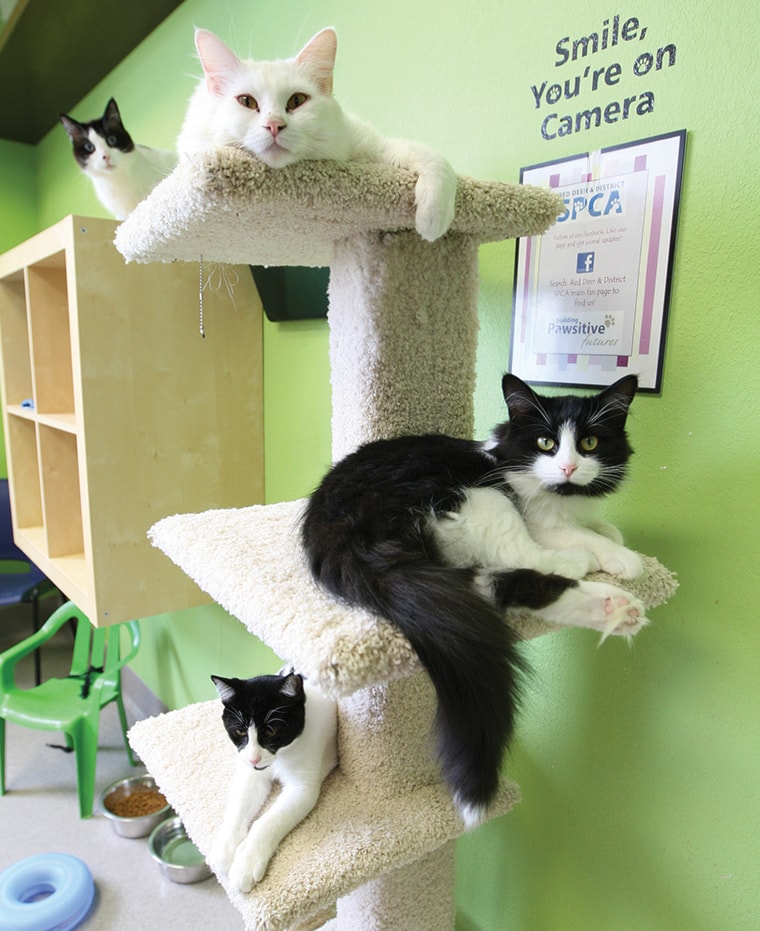The plight of hundreds of thousands of unwanted cats across Canada each year is causing great concern among animal shelters and other organizations, say attendees at a provincial meeting in Red Deer on Thursday.
The Red Deer and District SPCA, Edmonton Humane Society and Calgary Humane Society hosted a meeting that drew 38 people representing more than 20 organizations from around Alberta. All were on hand to begin seeking community-based solutions to cat overpopulation.
Barb Cartwright, CEO of the Canadian Federation of Humane Societies, was leading the meeting as part of a national tour to find out how to deal with Canada’s cat crisis.
“Our shelter system in Canada is at or over capacity to deal with cats that come through our doors,” said Cartwright after the day-long session at Sheraton Red Deer Hotel. “Only about 44 per cent of them get adopted out. Many of them have to wait and the longer they wait, the likelier they’ll become ill or become euthanized.”
Cats are five times more likely to be euthanized than dogs, said Cartwright.
This data, collected from more than 478 stakeholders, was compiled in the federation’s recent comprehensive report, Cats in Canada. The report says there’s an estimated 10.2 million owned cats in Canada and the owned cat population is growing faster than the number of households.
A total of 37.7 per cent of all Canadian households owned a cat with an average number of 1.9 cats per household. Based on market research, 80 per cent of owned cats have been sterilized, leaving 20 per cent unaltered.
It’s projected that more than 600,000 homeless cats in Canadian shelters did not find homes in 2011. More than one-third of the cats surrendered to shelters were surrendered due to issues of housing, followed by the animal taking up too much time or responsibility.
At this point, if large-scale, targeted action is not taken, the cat overpopulation problem will worsen, says the report.
Cartwright said they hope these meetings will result in concrete actions at the local level in the next year. The federation will look at how it provide resources at the community level.
A Central Alberta strategic alliance has been formed which includes Red Deer and District SPCA, Whisker Rescue Society of Alberta, Town of Innisfail bylaw department, and Alberta Animal Services, which is contracted by the City of Red Deer to provide animal control.
Tara Hellewell, executive director for the SPCA, said that everyone in this industry is feeling the strain of cat overpopulation due to irresponsible pet ownership, lack of spaying and neutering, and the view that cats are disposable.
“People are very concerned — they don’t want to see kitties out in the streets, going hungry and getting frostbite,” said Hellewell. “And sometimes people don’t like them roaming around their backyards and attacking songbirds. So there’s a number of reasons why it’s a challenge for our population. The Red Deer and District SPCA wants to be at the forefront of solving the problem.”
The shelter is always full and so the shelter must often turn people away who have cats to drop off. The SPCA doesn’t euthanize for space, but other organizations or municipal services are having to do this, she added.
“Veterinarians are key because some of the initiatives we want to start are spay and neuter programs, especially for low-income folks,” said Hellewell.
Erica Coomber, shelter administrator with Alberta Animal Services in Red Deer, said the cat crisis is highly evident in Red Deer. Ninety-five per cent of the cats that end up with Alberta Animal Services are not neutered or spayed, not tattooed or micro-chipped, or collared.
“We claim out maybe one per cent,” she said.
The biggest problem in Red Deer on why cats are given up is due to rental housing rules, she said.
Coomber said they have a really good adoption program where the cats are given to Petland Canada to adopt. Not one adoptable cat has been euthanized so far, she said.
They may receive 700 to 800 cats a year and of those, about 20-30 per cent are euthanized because they are feral or sick and therefore deemed unadoptable, Coomber said.
Stacey Worobetz, founding director with Whisker Rescue, said it’s hoped that a fund can be set up, perhaps with the help of corporate donations or other sources, where it can be accessed for low-income families so that spaying or neutering can happen.
ltester@www.reddeeradvocate.com
